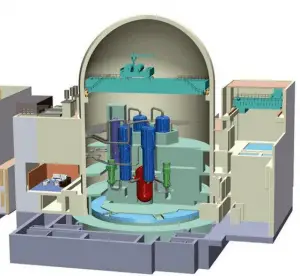What is Containment Building
The containment building is a gas-tight (shell) or other enclosure around a nuclear reactor and a primary circuit. The Containment is the most characteristic structure of a nuclear power plant. Practically all nuclear power plants built during the last few decades include a containment building.
The containment building should be designed to ensure or contribute to the achievement of the following safety functions:
- Confinement. Confinement of radioactive material in operational states and accident conditions.
- Protection. Protection of the power plant against external natural and human-induced events
- Shielding. Radiation shielding in operational states and accident conditions.
While the Containment plays a crucial role in Design Basis Accidents or Design Extension conditions, it is “only” designed to condense steam from primary coolant and contain it inside the building.
In case of Design Basis Accidents such as the Large Break Loss of Coolant Accident (LBLOCA) the pressure increase is usually significant and active containment systems (pressure-suppression systems) must be available in order to maintain the integrity (to keep the pressure and temperature under certain limits) of the containment building.
